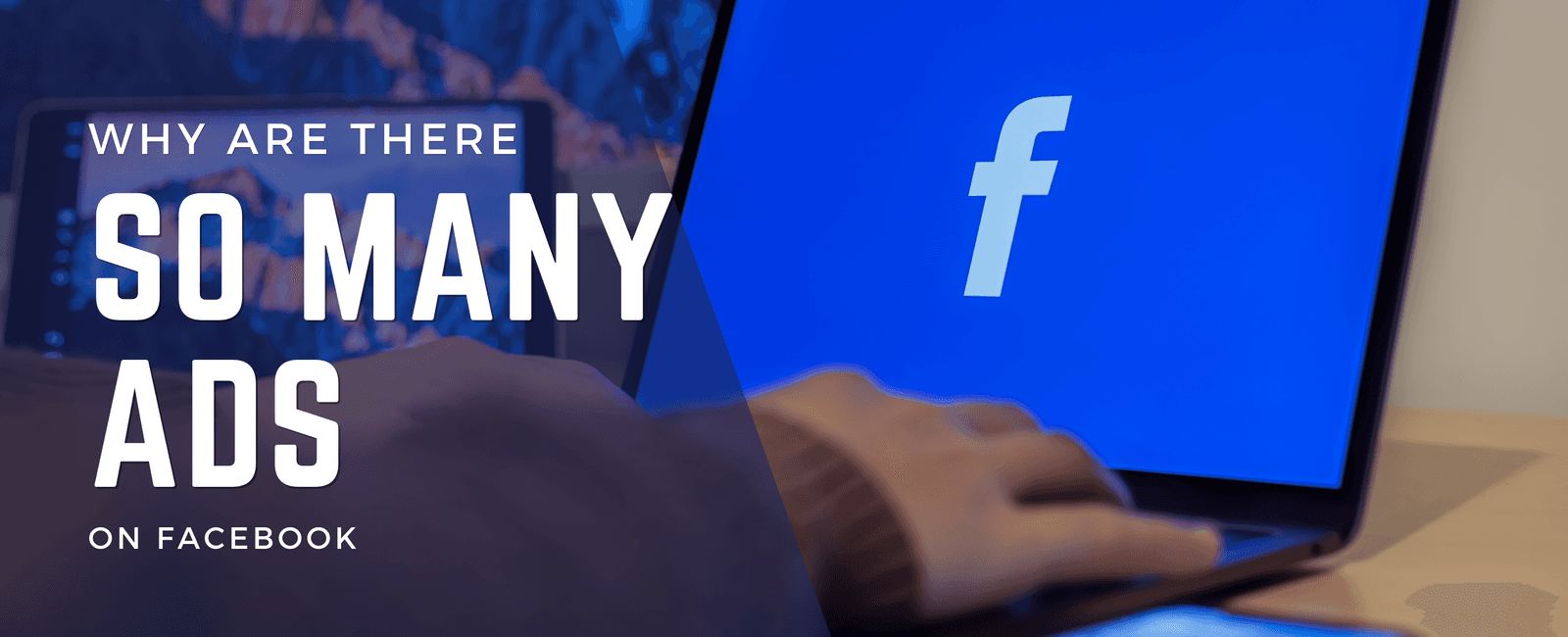Why Are There So Many Ads On Facebook?

During the 2018 Facebook Cambridge Analytica data scandal hearings, Senator Orrin Hatch asked Mark Zuckerberg, “how do you sustain a business model in which users don’t pay for your service?”
“Senator, we run ads.” Zuckerberg retorted with a smile.
If you’re a frequent Facebook user, you’re more than familiar with the countless ads that pop up on your Facebook home page as you scroll through posts from your friends, family, and pages you follow.
And yes, it can be extremely annoying.
Not only are ads annoying, but more often than not, they also seem to be suspiciously perfectly targeted to your likes and interests. One minute you’ll be window-shopping for bedroom decor, and the next minute you’ll see an ad on Facebook for throw rugs and table lamps.
So, exactly why are there so many ads on Facebook? How does Facebook seem to whip up the perfect ad for you–and then also get it wrong so often? Most importantly, how can you customize Facebook ads and improve your viewing experience? Let’s find out.
Why Does Facebook Have Ads?
Facebook allows its users to use its tools and services for free. However, it is still a business that needs to make money for its shareholders. So, if not from its users, where does Facebook earn its revenue?
At first glance, the answer is simple: through advertisements.
In 2021, Facebook (or Meta Inc., to be more precise) generated 114.93 billion dollars in ad revenues. In fact, over 97.9 percent of Facebook’s global revenue was generated through advertisements, the rest being payments and fees revenues.
Facebook has been generating ad revenue since its conception in 2004. Over the years, the amount of advertisements has increased exponentially, mainly because Facebook’s popularity has also increased exponentially.
Advertisements are an integral part of any business seeking to promote its products and services. With Facebook attracting as many users as it does, it is the perfect platform for different businesses to run their ads efficiently. Simply put, these businesses pay Facebook to run advertisements for their products and services. Hence, Facebook’s entire business model is dependent on ads.
In Q1 of 2022, Facebook generated more than $12 billion dollars, a slight increase over the same quarter last year–and that means Facebook is running more ads. It’s important to note that the average revenue per user varies quite a bit based on the country where an ad is served. You can read more about that in the investor relations portal
Meta does more than own and operate a family of apps. Their reality labs and other experimental products represent exciting opportunities to change the way the platform is monetized. As Meta increasingly focuses on these new product lines, we may see a number of shifts to the way platforms like Facebook and Instagram operate.
How Does Facebook Target Its Ads?
In online marketing, advertisers have to make a choice about who will see their ad (or “creative”). Different platforms like Facebook, Google, and TikTok all offer advertisers different types of products designed to reach specific objectives.
For example, some brands are easy to forget about. For example, many insurance companies buy advertisements to help make sure that their business is remembered not just when a customer is in trouble, but the rest of the time, too. These are sometimes called “awareness” or “reach” ads, and they’re designed to connect with as many people as cheaply as possible. Other brands want to get the public to check out a new application or game. They might use mobile app install ads to reach this goal. These ads pay attention to when an app is downloaded and launched, and that can help the brand ensure they are reaching people who are actually interested in their game. Many individuals started small businesses during the pandemic when it was easier to get free exposure online. As that has begun to change, they too are interested in different types of ads. Many e-commerce companies use ads to help remind visitors when they have items in their shopping carts or when they may be eligible for a promotion or coupon.
Businesses have a duty to their customers to use their information responsibly. At the hpl company, we believe that means that we have an obligation to help our clients use the least amount of information possible to accomplish their task. We also believe that a business should be very intentional in how it targets their advertisements.
“Ad targeting” refers to how advertisers determine what people will see a specific piece of content based on a variety of information including behavioral data (their likes, interests, and activities), company customer data, and data platforms like Facebook and Google assemble and make available for anyone to use.
Savvy advertisers are almost always looking for less competitive opportunities for their clients. Unfortunately, the majority of advertisers in the industry today are incentivized to instead reach spend goals with as little work as possible. As a result, many ads are broadly targeted, generic, and demeaning.
Facebook lets advertisers target ads using user information, like:
- Location
- Age
- Gender
- Interests
- Connections
- Relationship Status
- Language
- Education
- Workplaces
As Facebook learns more about users, it can better control the type of both organic and paid content they see.
The list above is by no means exhaustive. Information such as your interests, age, and location may not seem particularly private, but Facebook can put together a picture of your life, too.
For example, Facebook might notice your location has changed or that you’ve been researching air fare, and put you into an audience advertisers could use to promote other traveling-related ads to you. Facebook could learn that you’re an animal rights activist as it observes the number of animal welfare pages you interact with and the ways in which the content you share influences others.
Your friends’ Facebook activities can influence the ads you see on Facebook, too. Facebook allows advertisers to target their ads to “friends of people who like your page.” That means you may be viewing many ads for things you have no interest in, simply because you have a close friend that does. That ‘close’ friend might not even be someone you speak with frequently.
When advertisers are lazy about how they target, their ads often end up being shown to the same people over and over again. Brands need to do a better job of this, and as customers, it’s ok to tell them!
Facebook Advertising Transparency and Authenticity
In 2017, Facebook updated its ad transparency policies after the 2016 U.S presidential election fake ads scandal.
During the election period, hundreds of fake Facebook pages originating in Russia purchased upwards of 1 million dollars in ad buys for campaign messaging, fueling racial and religious tensions among U.S voters. After the fact came to light, Facebook was under global scrutiny regarding its ad policies.
Facebook responded by upping its efforts for ad transparency allowing users to know more about the ads they see. These efforts include:
- Showing users which posts are advertisements.
- Allowing users to click “view ads.”
- Requiring political advertisers to verify their identity
- Creating an Ad Library that shows every ad running on the platform and how it is targeted
While these changes have certainly begun to make more information about the platform available to researchers and the general public, they are still rather far away from a solution for the ad fatigue so many of us feel using Facebook these days.
Can You Stop All Ads From Your Facebook Home Page?
Here’s the million-dollar question: how can you stop viewing all ads on Facebook and scroll through your homepage in peace?
Well, the only way to stop seeing ads on Facebook is by deleting the app altogether.
Given Facebook’s business model, which is dependent on ad revenue, Facebook has made it very difficult to opt out of viewing Facebook ads. They’ve been famous for blocking big platforms like Ad Block for example. Some users have been able to block Facebook completely using tools like pi hole, but they often find that because so many websites include Facebook tracking pixels, this can have some unintended impacts.
So, if you want to continue using Facebook for free, you might just have to deal with the ads.
How to Adjust Ad Settings on Facebook
While you can’t get rid of all the ads on Facebook, or the total number of ads you see, you can control the type of ads you see by going to your “Ad Preferences” page:
- Click the drop-down menu button on the top right of the Facebook app. You will see this as three lines stacked on top of each other.
- Select the “Settings and Privacy” option, then select “Settings.”
- Scroll down to the “Permissions” section.
- Click “Ad Preferences.”
On this Ad Preferences page, you will see the advertisers from which you have most recently seen ads, select your topics of interest, and control the way Facebook uses your data.
You can perform these actions through the following tabs on top of the Ad preferences page:
- Advertisers: In this section, you will see all your recently viewed ads. You can also view which advertisers you’ve hidden and whose ads you have clicked.
- Ad topics: Here, you can filter through the topics of ads that will be visible to you. For example, if you don’t want to see ads about alcohol, you can select the “see fewer” option. Bear in mind that you might still see ads related to these topics, but to a lesser degree.
- Ad settings: You can adjust how Facebook uses your data to show you ads through ad settings.
By frequently reviewing your ad preferences, you can have some control over the kinds of ads you see on Facebook. To reiterate, though, you can not control the number of ads you see on Facebook.
Conclusion
Advertisements on Facebook can be annoying, but at the moment, they’re unavoidable.
Facebook earns almost all of its revenue through businesses that pay the platform for running their ads. This is why there are so many ads on Facebook.
However, you do have some control over the types of ads you see and how Facebook uses information about you to target those ads.
Share
Table Of Contents
Related Posts
Legal Stuff

